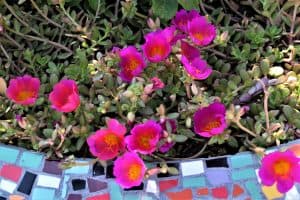
The lovely, moist succulent known as Purslane, is 93% water, features dark magenta stems, and rich green, rounded leaves. Also known as Portulaca oleracea, this nutritious, edible weed has collected some colorful nicknames over the years, including little hogweed, pigweed, and fatweed. A 1st-century historian named “Pliny the Elder” suggested that 1st century Romans used Purslane as the primary vegetable during dinners and as a crunchy addition to salads. Some 18th-century French farmers were known to hate the plant, saying “it’s a mischievous weed meant for pigs.” The herb can be found in Africa, North America, Asia, and Australia.
“I have made a satisfactory dinner on several accounts, simply off a dish of purslane, which I gathered in my cornfield, boiled, and salted.”
— Henry Thoreau
Some say that Europe is Purslane’s native home, but given its succulence, it most likely originated nearer to deserts. The plant has been native to India, Greece, and Persia for centuries, but may have first appeared in North Africa some 4,000 years ago. Some archeologists suggest the plant is prehistoric. Slightly sour and infused with nuanced flavors akin to watercress and spinach, the fleshy Purslane is loved by millions throughout the world.
This jade-like plant can be sautéed, juiced, boiled, pickled, drenched in butter, or featured in a delicious salad with oil, salt, and vinegar. It’s a versatile weed that can be grabbed from the Earth and immediately consumed. As it’s often found in plentiful heaps strewn across the countryside, the plant is easy to grow and has provided helpful sustenance throughout the ages, especially during times of famine.
Backed by a colorful and fruitful history, Purslane promises a long list of wonderful health benefits. It’s remarkable that this one plant can provide so much for us!
- Helpful in preventing lung and other cancers
- Aids in weight loss
- Improves and protects cardiovascular health
- Strengthens bones against osteoporosis
- Reduces eye inflammation
- Reduces inflammation on or near stings, bites, and cuts
- Improves vision and reduces cataracts
- Improves blood circulation
- Heals some digestive tract diseases
- Helps to prevent anemia
- Helpful in losing weight
- Reduces the appearance of wrinkles and blemishes
- Reduces occurrences of heart attacks and strokes
- Reduces effects of childhood disorders like autism and ADHD
- Helpful to the liver
- A natural diuretic
- Reduces occurrences of psoriasis
- Treats headaches
- Helpful in treating diseases related to the intestine, liver, stomach, cough, shortness of breath, and arthritis
- Chock-full of antioxidants, which can neutralize free radicals
Purslane is wonderful for our health in a variety of situations, but it’s also a superfood. This leafy green vegetable is action-packed with omega-3 fatty acids, antioxidants, and a variety of helpful minerals. In addition to the value derived from its unique pigments, Purslane is truly one of the most generous and nutritive foods on planet Earth.
- Magnesium
- Manganese
- Potassium
- Glutathione
- Calcium
- Vitamins A, E, and C
- Highest levels of alpha-linolenic acid, an essential omega-3 fatty acid
Many scientific studies focused on Purslane have shown that it’s of better nutritional quality than most of the world’s major cultivated vegetables. It’s also popular in Chinese medicine for the treatment of hypertension.
While all the good news might make you want to run out and harvest baskets full of Purslane, the herb should only be consumed in modest portions. Infused with 1.7% oxalic acid, it can do more than just agitate folks with digestive disorders and kidney stones. Since oxalates can inhibit the body’s ability to absorb minerals, for some, the herb can be problematic. If you love Purslane and refuse to give up the obsession, you can combine the weed with yogurt or kefir, which will decrease the herb’s levels of oxalate.
Yummy Purslane Recipes
Here are a few simple ways to enjoy Purslane:
- Purslane Salad: Chop your purslane leaves with some radishes, bell peppers, and tomatoes. Add splashes of apple cider vinegar and olive oil. Salt and pepper to taste.
- Purslane Spinach Sauté: Heat some oil, butter, and garlic in a pan, throw in a few cups of lightly chopped spinach and purslane. Cook for no longer than 2 minutes. Add a bit of honey and salt to taste.
- Stuffed Purslane Avocados: Cut (4) avocados in half, scoop out the avocado meat (save the 8 half-shells), and mix in a bowl with lightly chopped purslane. Add a little chili pepper, some lemon juice, olive oil, and walnuts. When your concoction is well-mixed, scoop it back into your avocado shells.
- Purslane & Your Favorite Meats: Purslane is a delicious companion to duck, lamb, and fish. After cooking your meat with garlic, marjoram, curry, and/or salt, add a cup or two of freshly chopped purslane.
- Peaches & Purslane: Chop together a few peaches and a cup of purslane and you’ll enjoy a nicely balanced flavor of sweet and sour. Add an ounce or two of freshly squeezed orange juice. Some might also add a sprinkle of salt or spice.
Vegetarians And Futurists Unite!
Because Purslane is such a significant source of omega-3 oils, it can be a vital contributor to the health of vegetarians, who tend to avoid fish-derived oils. With uncommon nutritional value, Purslane will most likely emerge as one of the most important foods in our Earth’s future. It’s quick to grow, easy to harvest, and doesn’t require a host of fertilizers. With more than 500 known species, Purslane is available throughout the world.




